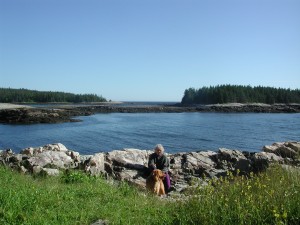Since I live in Gouldsboro, Maine, I go to the Schoodic section of the Acadia National Park, the quiet place.
When we moved here in 1976, we visited Schoodic every Sunday for a picnic or to look at the ducks. Bill and I drove the loop, stopped at several pull-offs, and hauled out binoculars to speculate as to the number of eiders there might be in the raft just off Blueberry Hill or between the mainland and Little Moose Island.
As our lives became more complicated with grandchildren, expanded farm, new musical interests, our Sunday drives became sporadic. Instead of “Time to go to Schoodic,” we said, “We haven’t been to Schoodic for ages. Want to go?” Now that we are hovering on the edge of elderliness, we have found time to go back more often.
I ask myself why I’m drawn to the place. A quick drive with Bill shows us the big scene. Yes, of course, it’s one of the most beautiful spots on the Maine coast. And yes, the waves crash on outcropping rocks that point toward Spain and picture-postcard scenes pop up at every curve.
When we stop at our old picnic site, memories of my parents, now long dead, become clear. My mother spreading out my best tablecloth and sending one of the children to pick wild flowers to place into the Wedgwood vase that she insisted we bring in the picnic basket. My father showing my son how to skip stones into the still water on the lee side. I pick up a very flat stone, hold it in my throwing hand, stoop low and heft it as hard as I can. It skips five times toward the lighthouse.
But today I drive down alone and stop along the way. A gray granite boulder plays host to barnacles and I stoop close enough to see the creatures inside. Rockweed hangs from it, grasping clumps of mussels. On the high side of the boulder, where the sea’s held at bay, beach peas bloom in pinks and purples, hoping to attract a wasp or perhaps a monarch.
And in an epiphany, I know why I am drawn to this place. The small things. When I was a child, like all children, I was much shorter than I am now. I noticed small things like shrimpettes (that’s what I called them) and pollywogs and those itsy white daisies barely poking through their own leaves.
Now, in my sixties I stoop a bit, look down as I walk, afraid to trip, not as confident as I once was. And, today, like I did in childhood, I see the small things.
I walk crab-like on hands and feet to a small pool in the rocks at the point, ancient gold and yellow lichens cushioning my palms. I lie down and peer into its blackness. Periwinkles speckle its stone banks and mosquito larvae hang on its surface. And something else wiggles under the surface. “Oh. Shrimpettes.” I say it out loud in a child’s voice and quickly look around to make sure I’m the only one to hear.
Just at the back of the pool, one blue flag iris struggles twixt rectangular dikes of black basalt wedged between pink granite. A rose bush grows seemingly out of rock and at the top, a deep pink flower. I sniff its center.
At Blueberry Hill, within my reach are wild strawberries, green with a tinge of pink, and blueberry bushes thick with white blossoms. I view the small offshore islands through Queen Ann’s lace. I crawl past them toward a cluster of pineapple plants, usually spurned because they’re a sign of poor soil. When I rub the yellow nubbin between my fingers the scent of pineapple infuses the air.
The Schoodic section of Acadia gives us both the grand and the infinitesimal. Scenes of Cadillac in the distance, bonsaied pines growing out of ledge, ocean smashing onto granite at the point, are all truly splendorous. But if you are a small child or an aging adult or you get right down on your belly, you will experience the microcosmic world of glory that we often miss in the rush to live in our modern world.

